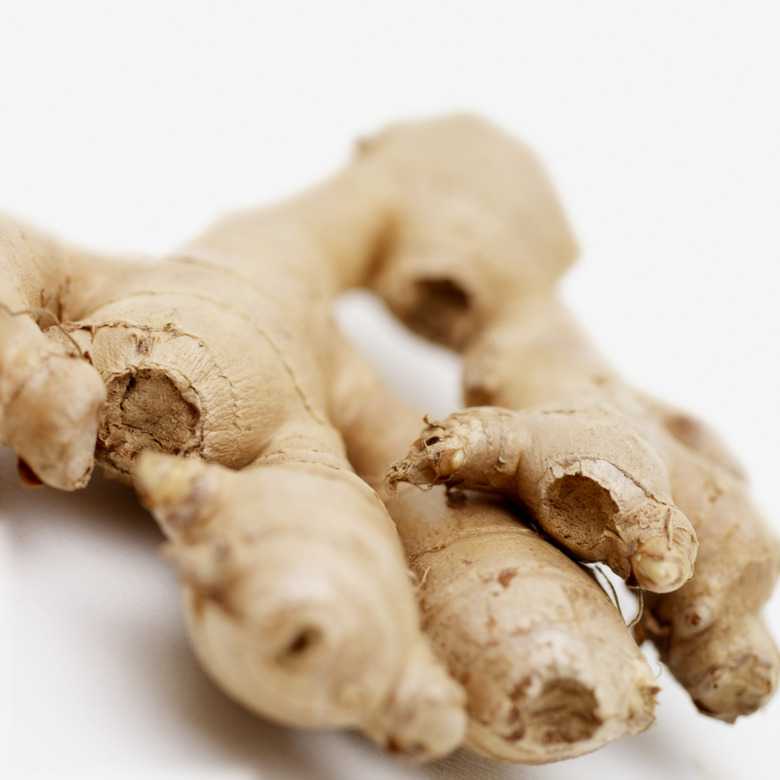Varieties Of Ginger
Ginger (Zingiber officinale) seems like an exotic plant, and it is, in a way. It originated in the steamy Far East, and most commercial ginger is still grown in India, Africa and southeast Asia. It's not hard to grow exotic ginger if you live in a warm climate. If you live in a cool climate, grow ginger in a pot and bring it indoors for winter.
Culinary Ginger
Step 1
Ginger is a tropical perennial native to the hot and humid parts of Asia, and it is the species most commonly used around the world for its edible rhizome. Hundreds of varieties — or cultivars — are grown commercially. Ginger grows in U.S. Department of Agriculture plant hardiness zones 9 through 12, and it does best in areas with partial shade. Growing ginger in a pot that you can move indoors is an option in cooler climates. If you want to grow your own edible ginger roots, you can start with a piece of fresh ginger root from the grocery store. You'll have to water the plant well after it develops top growth, protect it from temperatures below 50 degrees Fahrenheit, and give the plant several months to develop a rhizome that's large enough to use in the kitchen.
- Ginger (Zingiber officinale) seems like an exotic plant, and it is, in a way.
- If you live in a cool climate, grow ginger in a pot and bring it indoors for winter.
Grocery Store Ginger
Step 1
The varieties of ginger most often sold in grocery stores in the U.S. are usually called Chinese ginger or common ginger, and they are usually imported from India and China. These varieties have relatively large rhizomes and a more subtle flavor than varieties with smaller rhizomes. Common ginger plants reach heights of about 4 feet, with a spread of 2 to 3 feet, when they have adequate space in which to grow and good growing conditions. The plant itself is not particularly attractive and doesn't produce showy flowers. More than 50 cultivars are commonly grown in India, and even more are grown in China. Important Indian varieties include "Rio de Janeiro" and "Nadia"; important Chinese cultivars include "Gandzhou," "Shandong Laiwu" and "Guangzhow."
Small-Rhizome Gingers
Step 1
Varieties of ginger with smaller rhizomes than those of Chinese gingers are called Japanese gingers. They have a more intense flavor than Chinese ginger, but they can be used in cooking in the same way you use Chinese ginger. "Sunti" and "Kintoki" are examples of strong-flavored, small-rhizome ginger cultivars. "Sanshu" is a common Japanese cultivar with medium-sized rhizomes, and "Oshoga" is a relatively large-rhizome Japanese ginger.
- The varieties of ginger most often sold in grocery stores in the U.S. are usually called Chinese ginger or common ginger, and they are usually imported from India and China.
- Sunti" and "Kintoki" are examples of strong-flavored, small-rhizome ginger cultivars. "
Ginger Relatives
Step 1
Some ginger relatives produce more attractive flowers or leaves. While some produce flavorful rhizomes, they are more often used as ornamental plants. Mioga ginger (Zingiber mioga) forms upright clumps of leaf stalks that can reach 3 feet tall; "Dancing Crane" mioga ginger (Zingiber mioga "Dancing Crane") is a particularly hardy cultivar that can survive winters in USDA zone 5 through 10. Pinecone ginger (Zingiber zerumbet), which is also sometimes called shampoo ginger, produces showy, pinecone-shaped flower bracts. Pinecone ginger typically grows to about 7 feet tall, but varieties such as "Darceyi" (Zingiber zerumbet "Darceyi") are smaller, reaching only about 4 feet. Pinecone ginger grows in USDA zones 8 through 11.
